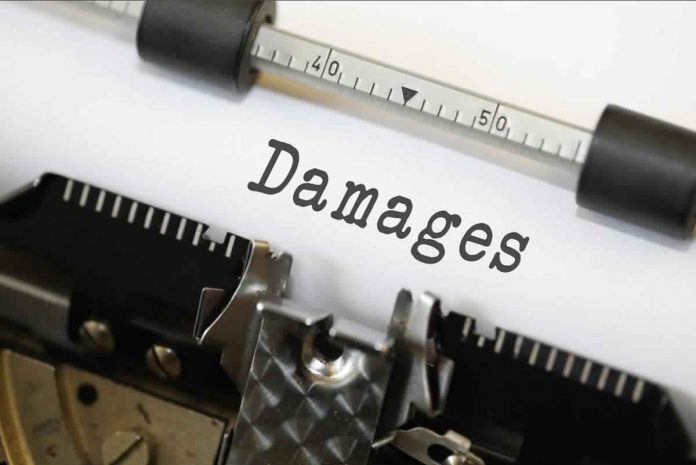This article is written by Adarsh Singh Thakur, 3rd-year student, Indore Institute of Law. He discusses about what damages are awarded in tort law and what methods are used by the courts in calculating them.

Meaning of Tort
A tort is a civil wrong which means that whenever a person commits an unlawful act under this law, the nature of the case filed in the courts is of civil nature. In civil cases, the person usually files the case himself so that he can claim compensation from the person who has caused loss to him by his unlawful act.
Meaning of Damages
There are many remedies which are available to the injured person and the most common remedy is the award of damages. Damages is that amount of money which the injured person gets from the person who caused injury to him.
In a claim for damages, the person should have suffered a legal injury because in case no legal injury happens a person cannot claim damages even if he suffered an actual loss. It can be understood with the help of these maxims:
Injuria sine damno, it means that there is a legal injury without any actual damage. Here the legal right of an individual is violated therefore he has a right to go to the court to enforce such right.
Damnum sine injuria, it means that there is actual damage but no legal injury and thus the person cannot go to the court to enforce his right because he has no such right in the absence of a legal injury.
Damages can be provided in the cases of injuria sine damno but not in a case of damnum sine injuria.
Another important point about ‘damages’ is that they are different from ‘damage’ even though they both sound the same they have a different meaning. Damage is the loss suffered by the person due to the wrongful act of another person whereas, Damages is the amount of money which is paid as compensation for the injury suffered by a person.
So, damages are different from damage and it is one of the remedies which is available to the plaintiff.
Liquidated and Unliquidated damages
Liquidated and unliquidated damages are both provided whenever damage is suffered by a person because of an unlawful act by another person and thus both are compensation paid to the injured person but they both differ from each other.
Liquidated damages are those in which the amount of compensation which has to be paid to the injured person is predetermined. It is usually paid in the cases of contracts where both the parties already know each other before the damage is caused by any of them and thus the Courts only have to enforce the condition of such damages.
Illustration: A enters into an agreement with B for selling his goods to B and in the terms of the contract it has been specified that if the goods are defective then A will have to pay a compensation of Rs.500 to B. If the goods turn out to be defective and B files a case against A then amount of Rs.500 will be paid by A. Such compensation falls in the category of liquidated damages.
Unliquidated damages are those damages which are not predetermined which means the amount which has to be paid is not decided before the injury happens to a person. Unliquidated damages are awarded in cases of tort because often the parties to such a case do not know each other before the commission of tort and therefore it is not possible for them to fix the amount of compensation beforehand.
Illustration: A commits the tort of trespass in B’s property and B brings a suit against him in the Court. Here the award of damages which B will receive will be unliquidated damages, as the amount of compensation will be determined by the Court.

Principle of Optimal Damages
In the law of torts, the Court while awarding damages to the injured person makes all the possible effort to ensure that the amount or quantum of damages is optimal. It means that the damages awarded by the Courts should be reasonable and sufficient and neither insufficient or over-compensation is given to the claimant.
In determining the optimal damages the following factors are considered by the Court:
- The nature and extent of the injury.
- Whether the liability of the defendant is vicarious or not.
- The relationship between the plaintiff and the defendant.
Thus after considering the relevance of these factors the Court decides the damages which have to be paid by the defendant in case he is found guilty of tort against the plaintiff.
Damages in Tort
In torts, the damages which are awarded by Courts to the plaintiff can be classified into several heads.
1. Nominal Damages
Nominal damages are those in which even though the plaintiff has suffered a legal injury at the hands of the defendant, there is no actual suffered by him. These damages are provided in the cases of Injuria sine damno in which the Court recognises the violation of the right of the plaintiff but the amount of damages are so nominal or low because of no actual loss to the plaintiff.
In the case of Constantine v. Imperial London Hotels Ltd., The plaintiff was a cricketer from West Indies who had gone to the defendant hotel to stay but he was rejected on the basis of his nationality, therefore, the plaintiff stayed at another hotel and did not suffer any actual damage. In the case brought by him, the defendant was held liable because the plaintiff’s legal right was violated despite no actual injury happening and they had to pay nominal damages of five guineas.
In the case of Ashby v. White (1703) 92 ER 126, the plaintiff was prevented from voting by the defendant and the candidate for whom the plaintiff was going to vote still won. The plaintiff sued the defendant. It was held that even though no actual damage was suffered by the plaintiff, the defendant was still liable for preventing him from exercising his legal right to vote and thus nominal damages were awarded in this case.
2. Contemptuous Damages
In these type of damages, the Court recognises that the right of the plaintiff is violated but to show that the suit brought by the plaintiff is of such a trivial nature that it has only wasted the time of the Court, the Court awards a meagre amount to the plaintiff as damages. This is similar to the nominal damages but the only difference between the two is that in nominal damages the plaintiff suffers no actual loss and in contemptuous damages, the plaintiff suffers actual damage but it is a trivial one in which he does not deserves to be fully compensated.
Illustration: If A’s dog enters B’s house and relieves himself and B accidentally steps on it and is disgusted and thus, he brings a suit against A, the Court will rule in B’s favour but because of such a trivial nature of this case the damages awarded by the Court will be of a meagre amount.
3. Compensatory Damages
Compensatory damages are awarded to help the plaintiff to reach his original position at which he was before the tort was committed against him. These damages are not awarded to punish the defendant but to restore the plaintiff to his previous situation. These damages are very helpful in cases of monetary losses in which the amount of loss can be easily calculated and therefore that amount can be ordered to be paid to the plaintiff so that he can replace the damaged product or goods with such amount.
Illustration: K takes T’s bike and due to his rash driving the bike gets damaged. Here K can be awarded compensatory damages in which the amount for repairing the bike will be payable to K by T so that the bike’s condition can be restored back to its original state.
4. Aggravated Damages
These damages are awarded for the extra harm which is caused to the plaintiff which cannot be compensated by the compensatory damages and it is given for factors such as the loss of self-esteem, pain and agony suffered by the plaintiff etc. which cannot be calculated in monetary terms. These damages are therefore additional damages which are awarded to the plaintiff other than the damages awarded for his pecuniary loss.
Illustration: A makes false claims against B as a result of which B’s standing in the society is greatly affected and he is also ridiculed by people which leads to him losing his self-confidence and self-esteem. Here Court can award B aggravated damages for the humiliation and loss of confidence because of his suffering which is caused by A’s act.
5. Punitive Damages
These damages are also known as exemplary damages and the purpose of these damages is to punish the defendant and to make an example of him so that others are deterred from committing the same act as he did. Thus, whenever a Court feels that the act of the defendant was severely gross, it awards punitive damages against him to the plaintiff.
Illustration: A company advertises that its pill will help in quick weight loss and is made up of natural ingredients, as a result, the plaintiff purchases it. But due to the pills containing certain chemicals, it makes the plaintiff severely ill. Here the Court can not only allow compensatory damages to the plaintiff but because of the company’s false claims, it can also award punitive damages so that it does not repeat the act again.
Calculating Damages
There are some rules which are applied in certain conditions for calculating the amount of damages in a case.
Damages in case of a reduction of life span
Whenever due to the tort committed by the defendant, the lifespan of the plaintiff is reduced, the amount of damages which will be awarded to him is calculated without taking into consideration his social status. The damages are not provided for the loss of the years of life but are provided for a happy life.
The happiness of life is calculated according to the subjective expectation of a reasonable man and not of the expectations of the plaintiff or how he thought his life was going to be. The damages which are awarded to the plaintiff are moderate.
Illustration: B suffers a severe injury due to the tort of A which has caused his life span to be reduced to 10 years. Here even though B was a rich person and enjoyed a good social status, the damages which will be provided to him will be done with the perspective of the requirements of a reasonable man.
Damages in case of death of a person
In calculating the amount of damages in cases where a person’s death is caused, two theories are used by the Courts:
- Interest Theory
In Interest theory, the Court determines the loss suffered by the dependant as a result of the death of the person on whom he depended. After such amount is determined, a lump sum payment is made which if deposited should provide that much amount of interest which is equal to the sum which has been determined by the Court.
Illustration: If A dies by the tort of B leaving behind C and the Court determines that the monthly loss suffered by C is Rs.5,000. Then the Court will order the deposit of such amount from which the interest which is earned, is equal to Rs.5,000.
- Multiplier Theory
In this theory if there is any loss which is likely to occur in the future as a result of the tort committed by the defendant, that likely loss is multiplied with a multiplier which indicates the number of years for which such a loss is likely to continue and the result of such a multiplication is the amount of damages which is awarded by the court.
Illustration: If A dies due to the tort of B leaving behind C who knows that she has to pay the mortgage money for their house for the next five years. Here, by applying the multiplier theory, the amount of mortgage which has to be paid will be calculated and will be awarded to C.
In United India Insurance Co. Ltd. v. Bindu & Ors, the deceased was riding a motorcycle when he was severely injured due to colliding with a tractor, which was driven negligently by its driver. The Court applied the multiple theory and fixed the multiplier at 13 with 6% interest p.a., for the award of damages.
Is Inflation a factor in determining damages?
While awarding damages, whether inflation should be considered as a relevant factor or not had been a big question of law and therefore differing views were provided both in favour and against its consideration.
But in the case of Jaimal Singh v. Jawla Devi, it was held that while determining the amount of compensation, a judge cannot shut his eyes to the factor of inflation and the fact that value of rupee is declining.
In Kerala State Electricity Board v. Kamalakshy Amma, the decision in the above case was upheld and it was observed that inflation should be considered as a valid factor in determining compensation.
Conclusion
Damages are the monetary compensation which is awarded by the Court to the plaintiff so that he can be enabled to make up for the loss which he has suffered because of the tort committed by another person. There are several types of damages and the calculation of damages depends on various factors such as the nature and extent of the injury, the relation between the plaintiff and the defendant etc. The calculation of damages is also different in different cases such as in the case of death of a person the interest and multiplier theories while for calculating damages while in case of shortening of life span the social status of the person is not taken into account.
 Serato DJ Crack 2025Serato DJ PRO Crack
Serato DJ Crack 2025Serato DJ PRO Crack










 Allow notifications
Allow notifications



